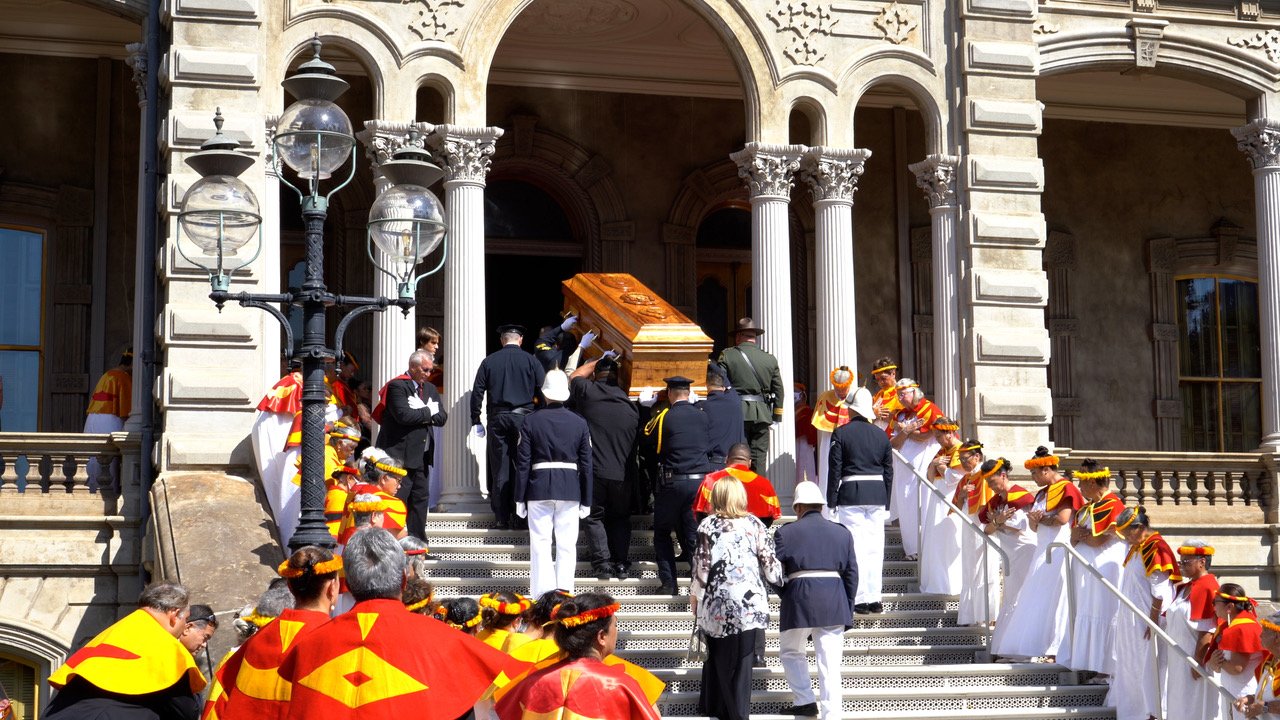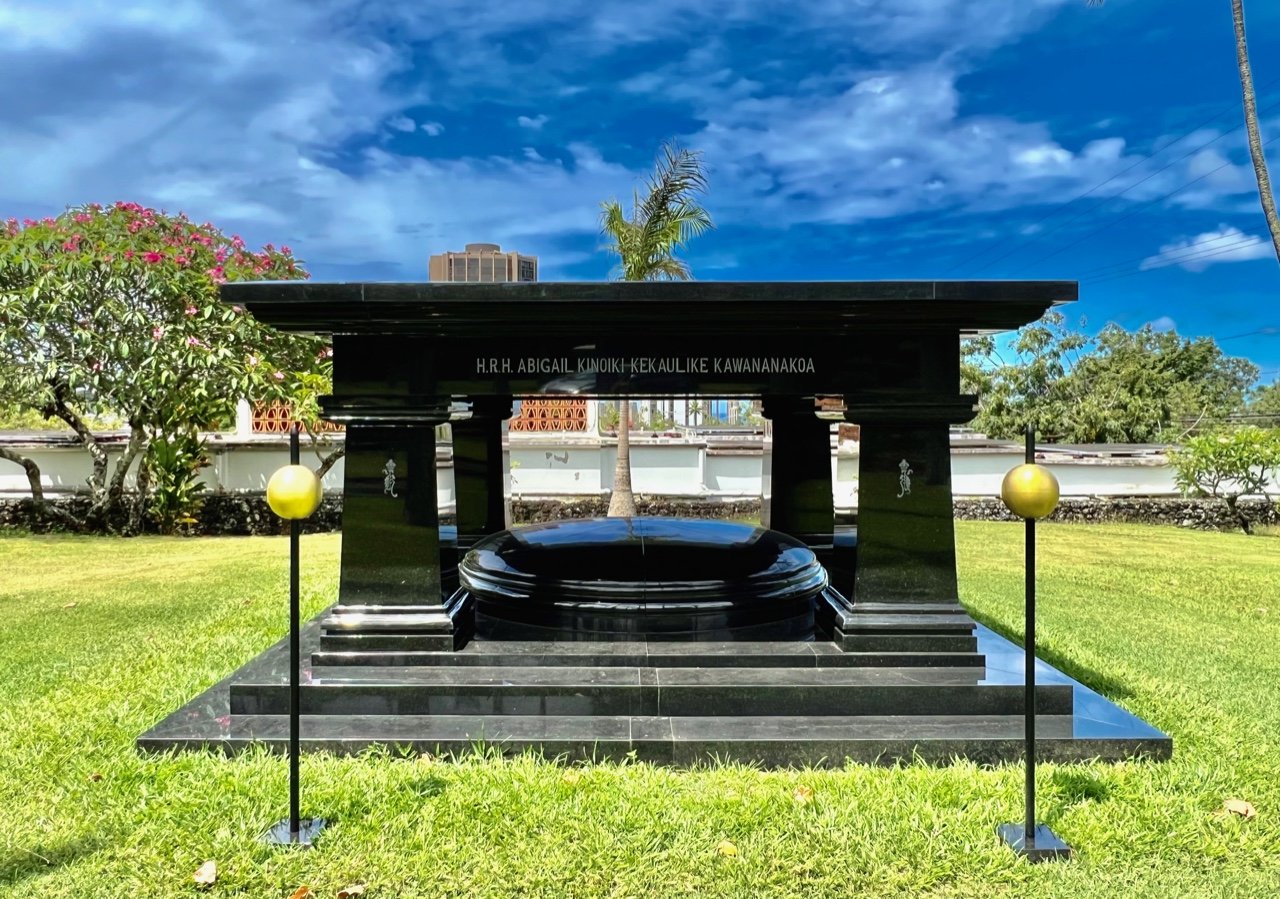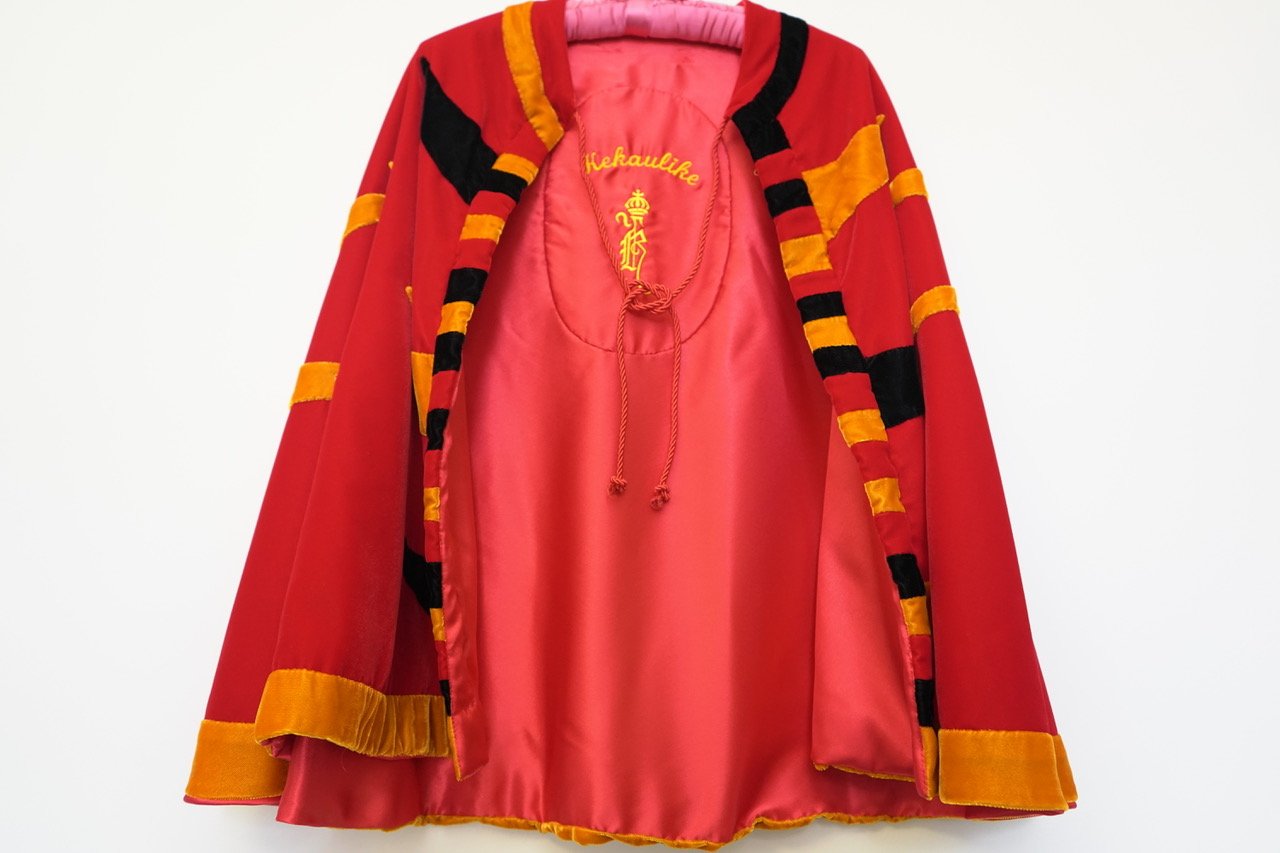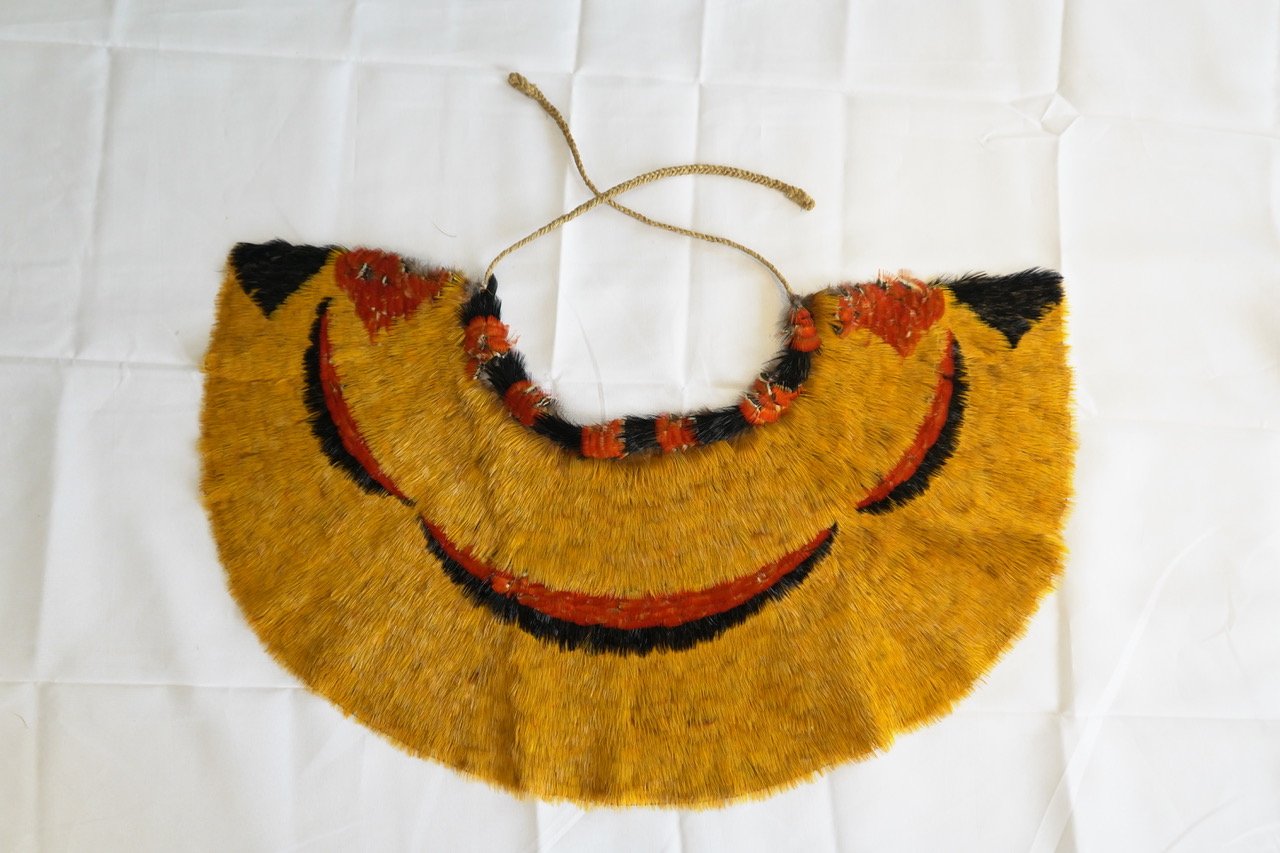Events Following The Death of Her Late Royal Highness Princess Abigail Kinoiki Kekaulike Kawananakoa
Princess Abigail Kinoiki Kekaulike Kawananakoa passed away at the age of 96 on Sunday, December 11, 2022.
A formal announcement of the Princess’s passing was made on the grounds of ʻIolani Palace. It was delivered only in ‘Olelo Hawaiʻi (Hawaiian language) by Paula Akana and Hailama Farden, the heads of ʻIolani Palace and the Hale Nā Aliʻi royal society, respectively.
The announcement begins in the video at left with Paula and Hailama descending the stairs of ‘Iolani Palace and walking down the main drive to the front gate at which time they made the announcement in Hawaiian before turning away and walking back up the drive.
Coverage of Her Passing
Lying-In-State
At ‘Iolani Palace, Throne Room
Sunday, January 22, 2023
“A somber day, at viewing for last Hawaiian Princess Abigail Kawananakoa” — KITV, January 22, 2023
“Public memorial held at Iolani Palace for late Hawaiian heiress Abigail Kawananakoa” — Hawaii News Now, January 23, 2023
“Princess Abigail’s memorial service attended with love” — KHON2, January 23, 2023
The Princess’s Casket
Princess Abigail’s majestic casket was handcrafted by Martin & MacArthur, which creates timeless Koa furniture inspired by designs owned by the Hawaiian monarchs and now at ‘Iolani Palace. The casket is crafted from a single 165-year-old Koa tree that fell during a winter storm in 2021 on Hawai‘i Island. Originally located in the Pu‘u Ō‘ō area between Mauna Loa and the Waiākea forest reserve, the tree served as nesting and protection for indigenous nene birds for generations, offering shelter from the buffeting storms that often swept across the area.
Built to approved specifications, the curly Koa wood casket features three Koa emblems on top: the Hawaiʻi Crown, the Hawaiʻi Coat of Arms, and Abigail Kawananakoa’s personal crest, the “Crown K.”
Shepherded by Martin & MacArthur President Michael Tam, the casket was created by the following craftsmen:
Simon McKenzie – found and procured the unique, curly Koa wood used for the casket
Guy Leslie – built the casket
Mel Pascual – carved all three Koa emblems on top of the casket
Michael Schwenke – shaped and built the customized sloped Koa molding on top of the casket
Stacy Hanohano – secured the mechanical hardware for the casket and created the sumptuous silk lining
Lying in state
The Princess’s public lying-in-state was held in the Throne Room at ‘Iolani Palace on Sunday, January 22, 2023.
The Princess’s koa casket arrived at ‘Iolani Palace via hearse through the front gate at 1:30 p.m.. A small procession accompanied the Princess with traditional Hawaiian protocol up the driveway. Hailama Farden of Hale O Nā Aliʻi provided traditional Hawaiian wailing while Manu Boyd chanted Princess Abigail’s lineage. A law enforcement honor guard carried the casket up the front stairs into the Throne Room, where members of the family and the Hawaiian Royal Societies kept vigil during Princess Abigail’s lying-in-state. The pedestrian gate opened at 2:00 p.m. for members of the public to pay their respects.
Princess Abigail was the 12th person to lie in state in the Throne Room of ‘Iolani Palace; Princess Likelike was the first after her passing in 1887. Other royals included King David Kalākaua (1891), Prince David Kawananakoa (1908), Prince Jonah Kūhiō Kalanianaʻole (1922), and Albert Kūnuiākea (1903), son of King Kamehameha III. While Queen Lili‘uokalani did not lie in state at the Palace, her private funeral service was held in the Throne Room in 1917; her husband, John O. Dominis, did lie in state in the Throne Room after his death in 1891. The funeral for Prince Edward Keliʻiahonui was also held in the Throne Room after his passing in 1887.
The Funeral of Princess Abigail Kawānanakoa
A private funeral service for Princess Abigail was held with close family and friends on Monday, January 23, 2023 at Mauna ʻAla.
Her Tomb at Mauna ‘Ala
On December 17, 2012, Princess Abigail applied to the State Board of Land and Natural Resources for approval to construct a tomb for her burial on the grounds of Mauna ʻAla. She received permission to be buried there in 2013. By lineage, she might have been laid to rest in the Kalākaua Crypt, but that Crypt is full and has no room for additional burials, thus necessitating the construction of a new tomb.
The Kawananakoa Tomb was designed by architect and builder Robert Mandich, who worked very closely with Princess Abigail as she had very strong wishes about the tomb design and its placement. The Princess’s tomb resembles the Wyllie Tomb, from which it will sit opposite on the grounds, though it is smaller and shorter.
The Kawananakoa tomb is made of black galaxy granite, which is the strongest of the materials that could be worked with for this tomb. It is black in color to match the Kalākaua Crypt features visible nearby.
I Ku Wohi – The Hale O Nā Ali‘i of Hawaiʻi Cape
There are four Hawaiian Royal Societies, orders which keep alive the rituals, practices, and protocols of the Hawaiian monarchy: The Royal Order of Kamehameha I, the Ahahui Kaʻahumanu, the Daughters and Sons of Hawaiian Warriors - Mamakakaua, and the Hale O Nā Aliʻi O Hawaiʻi. It is the last that is tied to the Kawananakoa Family and its legacy for Hawaiʻi.
Princess Abigail Wahiikaʻahuʻula Campbell Kawananakoa and her birth mother Lydia Liliʻuokalani Kawananakoa Morris were both members and leaders of this royal society. Her mother bore the rank of I Ku Wohi, or Third Regent. When she passed, that rank was passed on to Princess Abigail.
The deep red, yellow and black velvet cape given to Princess Abigail by the leadership of Hale O Nā Aliʻi specifically sets forth that rank. This cape was treasured by her as a symbol of that rank and of her membership in that royal society.
This cape will be donated to ʻIolani Palace for display in the upcoming Kawananakoa Legacy Gallery to be located in the basement of the Palace.
Kekaulikewahine – The Feathered Cape
Princess Abigail long desired a feathered cape to go with the Hale O Nā Aliʻi cape. She would on occasion look at feather capes but for whatever reason, never ended up acquiring one. Following her passing, noted Hawaiian Feather Master Rick San Nicholas was contacted about creating a feather cape to accompany her on her final journey.
He agreed and created Kekaulikewahine.
San Nicholas has descibed this work as paying homage to Princess Abigail’s direct lineage to Kauaʻi and to the House of Kalākaua. It consists of red and black design elements on a yellow background, which reflects the ancestry of Princess Abigail’s namesake and fifth great grandmother, Kekaulike, who was the daughter of Kauhiokaka and King Keawe II.
The three crescents represent the three Houses of Kalākaua, Keawe and Hulu. The color of scarlet on the crescents represents the color of the glowing lava off of the wings of the Manu. The black cover below reflects the black lava creating new land for the Hawaiian Islands. The Manu represents the highest standards as their ability to reach heaven. The triangles represent protection for the Princess and shows her approachable, open heart.
The Capes of Princess Abigail Kawananakoa
ʻAhu liʻi are feathered capes that were traditionally for royalty and high chiefs and chiefesses. (ʻAhuʻula are the longer cloaks.) They provided some level of protection when worn into battle, were said to provide spiritual protection and benefit, and were considered among the most precious of gifts that could be given to another.
The original Hawaiian ʻahu liʻi and ʻahuʻula (sometimes shortened to ʻahu) were made from the feathers of native birds. Most of those birds are now extinct and currently feathers come from pheasants, duck and other birds; often dyed to create the colors desired in the cape.
Capes can also be made of cloth; special ones sometimes in velvet for its rich texture.
Princess Abigail has two capes, one she has had for decades and the other a recent gift to her.
One aspect on all of their minds was the connection of law enforcement units to the Kingdom of Hawaiʻi. The two main units involved, the Sheriffs and HPD, both trace their founding to the reign of King Kamehameha III, and their ties to the Kingdom are very important to them.
In selecting the members of the unit, Koa felt strongly that that both the Sheriffs and HPD needed to be involved along with the Department of Land and Natural Resources and ʻIolani Palace staff. He wanted them to have a deep commitment to Hawaiʻi and to our history. Most were Hawaiian, but Mike Oakland’s family came here in the late 1800s and his connection to our past is very strong and personal. They all had to be very strong physically to carry the casket. And as Koa put it, “they had to be able to handle the weight -- not just of the weight of the casket but also the weight of this moment in our history.”
When the members of the units first got together, they were, as one person said, “a little standoffish.” In their day-to-day work, they have different areas of responsibility, which sometimes overlap and cause tension between them. Seeing themselves as a single unit was new to them. In addition, some of them did not have a lot of experience in the Honor Guard role and were learning that role through practice sessions. There was also however, as Kauahi pointed out, a core of experienced honor guards and Hawaiian men, including Kauahi, Ben Lloyd, Eric Castro, Daniel Del Toro and Cameron Tuitele, who could anchor the unit.
Both Kauahi and Oakland said that the unit really began to bond when they started to practice at the U.S. Air Force Honor Guard Training Facility. (Due to the number of ceremonies, and especially the number of burials of veterans that the armed services have in Hawaiʻi, there are dedicated color guard units with practice areas so that their actual participation in those events can be done with a very high degree of professionalism.) Our honor guard was given the opportunity to use the U.S. Air Force facility, for which they are all very grateful. And Oakland noted, “they were very patient with us.”
And the Honor Guard began to build strong personal relationships with each other, often finding meaningful family, school, and other connections By the end, they were truly a single team. And, as Koa said, “Abigail made us brothers.”
The unit started off practicing with an empty casket and hearse lent to them by Borthwick Mortuary. The unit would pull the casket out from the hearse, lift it, and carry it up and down the Palace steps.
There were decisions that had to be made along the way.
The biggest single decision involved how to carry the casket; to leave it on the mortuary “truck” (the rolling platform on which the casket is moved), to carry it by the handlebars on each side of the casket, or to carry her on their shoulders. They chose the last – to carry her on their shoulders. When they were with the military honor guard trainers, they were told that carrying caskets on shoulders was not done anymore. They chose to carry her on their shoulders anyway.
So why did they insist on this? Around the time that they were practicing for their honor guard role, Queen Elizabeth II’s funeral services were all over the news. And in those films, the Queen’s casket was being carried on the shoulders of the military honor guard unit. As one of our honor guard members said, “if the British can put their Queen on their shoulders, we are putting Princess Abigail on ours.”
They also made the decision to move the casket from the platform of the hearse truck up to their shoulders in a single motion. It is very difficult maneuver and requires a significant level of physical strength and agility. It was also visually stunning when we saw them do it. And it turned out to be the only way to actually handle the weight.
They also made the decision to have all the commands for their movements said in the Hawaiian language. This was significantly a matter of fitting into the history of Hawaiʻi and the way that Royal Family members’ funerals were conducted. The responsibility for these commands was entrusted to First Deputy Sheriff Koa. He first looked at the Hawaiian translation of normal commands and quickly came to the conclusion that a direct translation of English to Hawaiian would not work. Koa then reached out to the Royal Guard. He also reached out to Paula Akana of the Palace, who took his commands in English and gave them to an expert in the Hawaiian language. When that translation came back, he gave it to one of his deputy sheriffs and she adjusted them to honor guard command steps. Even then, he had to make some final adjustments as they actually moved with the casket.
Every member of the unit learned the Hawaiian commands. Koa, in leading the unit, had to handle the cadence, the spacing, and to constantly make adjustments in the moment, which the team needed to follow.
They practiced regularly at the Palace, especially up and down the Palace steps, and at the U.S. Air Force facility. They realized they would need to lift the real casket at least once before the actual day of the service, so they traveled up to Oʻahu Cemetery, where she was resting until the date of her services at the Palace and at Mauna ‘Ala.
(While the practice casket they used was a real one, made of mahogany, it was not her casket. Her casket, and that story is told elsewhere, was made from a single piece of curly Koa from the Island of Hawaiʻi.)
Princess Abigail, in her Koa casket, was brought into the Chapel of the Oʻahu Cemetery. She had been told in advance by Mary Voeller of Oʻahu that the Honor Guard would need to get a sense of the weight of her and her casket so they would not be surprised when they lifted the casket at the ceremony. Mary said that she felt the Princess’s support of her men getting ready to do this service, and she let the Guard members know that.
When the men lifted her, they were stunned. The practice casket had probably weighed around 400 pounds; her Koa casket probably doubled that. And when they put it up on their shoulders, the bottom edges of the casket base dug painfully into their shoulders.
The Honor Guard was then given the option not to carry her on their shoulders and instead to carry the casket by its side handlebars. Koa said that as soon as they were by themselves, he looked at every person there and said, “she is going on our shoulders” and he got total support. That decision was affirmed as they again watched the video of the Queen Elizabeth funeral on the screen at the Oʻahu Chapel. Again they said that if the Queen was carried on her honor guards’ shoulders, Princess Abigail would be on theirs. A bottom panel was added to her casket by its maker, Martin & MacArthur, so that it could be carried more easily by the Guard.
In sessions after that, the practice casket had 500 pounds of Olympic weights inside it.
On the day of the Lying in State ceremony, the grounds of ʻIolani Palace were filled with members of the Royal Societies, Kawānanakoa family members, and members of the public waiting to sign the koa guest books and enter the Palace to pay their respects to the Princess. As the hearse reached the foot of the Palace steps, the Honor Guard stepped forward and lifted the casket out of the hearse and began their slow march to the foot of the stairs and then up them, commanded entirely in Hawaiian.
Kauahi was at the very back because of his size and strength and he said that as the angle of the casket increased as they went up the steps, the weight in the back was staggering. Kauahi remembers whispering to her casket, “I won’t let you drop; I promise you Princess, I will not let you fall.” He also noted that the back of the casket was held up by Bo Kanekoa of the Palace staff and Benjamin Lloyd of HPD, and others, all very strong men and none of them would have let her fall.
The Honor Guard carried her up the front steps of ʻIolani Palace and into the Throne Room where she lay in state. At the end of that ceremony, they carried her down the back stairs and into the hearse, which drove up to Mauna ʻAla, where her funeral service would be the next day. The Honor Guard was waiting for her at MaunaʻAla and took her from the hearse and into the Chapel, placing her on its altar. She was then guarded overnight by the members of the Royal Societies. The next day, after the funeral service and the crowd had left, the Honor Guard took her from the altar and into the hearse for a return to Oʻahu Cemetery where she would rest until her tomb was completed.
When the tomb was done, a very private burial service was held. The Honor Guard were at Oʻahu to accompany her the short distance to Mauna ʻAla. Once there, they carried her from the hearse to her tomb, which had a small opening in the heavy dome that would seal it. The Honor Guard members moved the casket inside the tomb and then aligned her in a precise East-West configuration as was her desire.
There was one more task to be carried out. It is traditional for honor guards on occasions like this to place their gloves on the casket, never to be used again. On the day of her lying-in-state at the Palace, when her casket was brought up to Mauna ʻAla, the members of the honor guard, after carrying her into the Chapel and placing her on the altar, with all the dignity and care that they had afforded her that day, laid their gloves on her casket. And there they lay during the overnight vigil. In the morning, prior to the arrival of the family members and guests for the funeral service, the gloves were lifted off the casket and placed in a koa box made from the same block of curly koa used to make her casket. At the burial ceremony, that box of gloves was fittingly placed by Koa next to her casket in her tomb. They then exited her tomb. After the brief acknowlegements and service, the Honor Guard assisted in pushing the two halves of the thousands of pound tomb cap together, sealing the Princess in her tomb for all time.
When talking about this final service afterwards, Kauahi said that when they lifted her casket from the hearse to carry her to her tomb, she “felt oddly light. She was not heavy at all, and we all noticed it.” The Princess was finally home.
Only then did the Honor Guard consider its work done. When asked why they followed her through every step of the process, they were clear it was the commitment of an Honor Guard and the commitment that each of them had made to her personally.
A service well and truly done.
Members of the Princess Abigail Kawananakoa Honor Guard:
Lead Escort: Lieutenant Michael Oakland, Sheriff Division
Left Front: Sergeant Adrian Kanoa, Sheriff Division
Right Front: Deputy Scott Namuo, Sheriff Division
Left #2: Sergeant Daniel Del Toro, Honolulu Police
Right #2: Officer Cameron Tuitele, Honolulu Police
Left #3: Officer Henry Haina, DOCARE
Right #3: Officer Errol Kane, DOCARE
Left Rear: Officer Bo Kanekoa, ʻIolani Palace
Right Rear: Corporal Benjamin Lloyd, Honolulu Police
Rear Escort: Lieutenant David Kauahi, Honolulu Police
Left Flank Escort: Officer Eric Castro, Honolulu Police
Right Flank Escort - Honor Guard Commander: Chief Deputy Lanikoa Dobrowolsky, Sheriff Division
Honor Detail – Throne Room
Deputy Deven English, Sheriff Division
Deputy Andre Jackson, Sheriff Division
Officer Preston Kamauʻu, DOCARE
Officer Jasion Lee, DOCARE
Honor Guard Commands in Hawaiian:
[It turns out that there were no records that could be found of the commands in Hawaiian used by honor guards during the Kingdom. Koa therefore is preserving the commands used for the Princess in the event that future units are interested in looking at them.]
The Story of The Historic Kawānanakoa Honor Guard
One of the highlights of the lying in state and funeral ceremonies for Princess Abigail Kawānanakoa was watching her honor guard, made up of State and County law enforcement officers, lift her casket in a single motion, and then with commands in Hawaiian carry her on their shoulders up the steep stairway of ʻIolani Palace. Films of those moments and of that Honor Guard will be shown over and over again in the years to come.
What is the story behind that Honor Guard, how did it come to be and how did they decide how they were going to honor Princess Abigail?
Once the choice was made to have Princess Abigail lie in state at ʻIolani Palace, there was a need to coordinate with State and County law enforcement officials on everything from traffic control to line control to the potential for disruption if anyone chose to protest the ceremony. It was at that first meeting that the law enforcement units present, including the State Sheriff’s Office and the Honolulu Police Department (HPD), were asked if they would want to put together the Honor Guard for her services.
Lt. David Kauahi of HPD said, “we were taken aback by the request,” and that “they never thought they would ever be involved in such a historic event.” He said that a lot of those involved were Hawaiian men with long family histories of service going back to the Kingdom of Hawaiʻi. They knew it was a high honor and they felt very honored to even be asked. Mike Oakland of the Sheriff’s Office added, “we paused before saying anything. We were maybe a little scared or at least nervous. It was a complete honor.” Kauahi also said that while he had been involved in numerous honor guard experiences over the years, “this one was very different.” And First Deputy Sheriff Lanikoa (Koa) Dobrowolsky also noted that he had been involved in many honor guard roles over the years and that they were performed with professionalism and as much perfection as possible for the families of the fallen and yet, as he said, “this was so much greater as it goes not only to our Princess, it goes to our culture and to our history.” He said that while he is not the type to get nervous, he wanted this one to be done well.
And, of course, they said yes.









